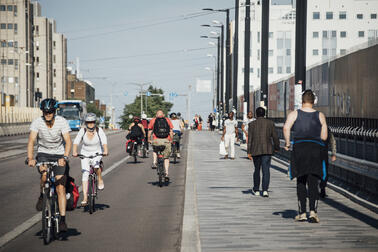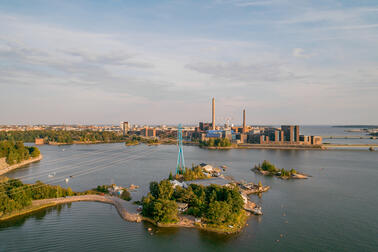
Emissions in Helsinki increased due to emissions from district heating
Helsinki’s greenhouse gas emissions increased by 12% in 2022 compared to the previous year. Emissions from other sectors mainly decreased, whereas emissions from district heating increased significantly. The increase in emissions was the result of the cessation of natural gas imports from Russia due to the war in Ukraine. As a result, Helen Ltd had to replace natural gas in district heating production with coal and oil. Compared to 1990, Helsinki’s total emissions were approximately 25% lower.
“Helsinki's emissions development shows that there is much to be done if we are to achieve carbon neutrality by 2030. The changes needed in energy production are large in scale, though at this point the causes of the emissions development were external and related to the war in Ukraine. Next year’s report identifies a move in the other direction, as the Hanasaari’s coal-fired power plant was closed this spring. As a result, the city’s total emissions will decrease by about 20%. A major transformation in district heating must be achieved in this decade,” says Anni Sinnemäki, the deputy mayor for urban development.
The carbon-neutral Helsinki programme was updated to meet the carbon-neutrality goal brought forward to 2030. Special attention has been paid to the effectiveness of the measures and how they contribute to efforts to reach the goal. The aim is to achieve emission reductions in accordance with the City Strategy, especially in heating, transport and construction. Measures to reduce emissions will be updated annually in the future, so that it will be possible to react quickly to technological developments, energy prices and changes in the global situation.
Work to protect biodiversity is bearing fruit
Helsinki was preparing four new local plans, all of which essentially set out from natural values. Biodiversity shows in detailed planning not only in the consideration and saving of natural areas, but also in the issuing of various planning regulations to build green spaces in the city. In 2022, the Urban Environment Committee approved a total of 51 revised local detailed plan proposals, 46 of which were not in conflict with the ecological network.
The updating of forest management principles in Helsinki in accordance with the new city strategy and the Biodiversity Action Plan was launched. The main goal is to systematically increase biodiversity and the natural ageing of forests.
The implementation of Helsinki’s ten-year nature monitoring plan also began.
“The annual monitoring results in a systematically documented nature information time series, which provides important information on the development of the state of biodiversity in Helsinki,” says Esa Nikunen, Director-General, Environment Services.
The share of nature reserves of Helsinki’s land area increased from 3.8% to 4.0% compared to 2021. Four new nature reserves were established in Helsinki in 2022. The ELY Centre made founding decisions for the forests of Kruunuvuorenlampi, Tahvonlahden harju, Rudträsk and Uutela.
Investments were made in the development of rail transport
Strong investments in the development of rail transport continued. The construction of Jokeri Light Rail proceeded faster than planned. The Kruunusillat rapid tram project and the Kalasatama-to-Pasila project also proceeded well. There was also progress with preparation of the West Helsinki tramline, the next rapid tram project
to be completed. Helsinki’s bicycle network was expanded in connection with the construction of Jokeri Light Rail, when Viikinbaana was completed from Roihupelto to Oulunkylä.
Passenger numbers in public transport increased, but did not yet return to the level before the Covid-19 pandemic. In 2022, passenger numbers in the area of Helsinki Region Transport (HSL) increased by 25 per cent in the metro, 26 per cent in buses, 32 per cent in trams and 33 per cent in commuter trains compared to 2021.
The number of electric cars continued to grow. The share of rechargeable cars of all cars in traffic in Helsinki was about 11.4%. The corresponding figure was 8.4% in 2021 and 3.4% in 2020. The city’s goal is that electric cars will make up 30% of all vehicles in Helsinki by 2030.
HSL introduced about 150 new electric buses and their total number increased to 328 in 2022. HSL’s goal is that by 2025, at least 30% (about 400 vehicles) of the bus fleet will run on electricity.
The Helsinki City Council discussed the environmental report at its meeting on 13 September 2023.
- City of Helsinki Environmental Report 2022 (online publication)(Link leads to external service)
- The environmental report as open data (Link leads to external service)
- City of Helsinki environmental accounts(Link leads to external service)
- Helsinki’s environmental statistics (Link leads to external service)


